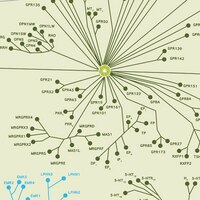HTS138M Sigma-AldrichChemiSCREEN™ Membrane Preparation Recombinant Human CXCR7 Chemokine Receptor
Human CXCR7 / RDC1 GPCR membrane preparation for Radioligand binding Assays & GTPγS binding.
More>> Human CXCR7 / RDC1 GPCR membrane preparation for Radioligand binding Assays & GTPγS binding. Less<<Prodotti consigliati
Panoramica
| Replacement Information |
|---|
Tabella delle specifiche principali
| Species | Host Cells | Protein Target |
|---|---|---|
| Human | Chem-1 | CXCR7 / RDC1 |
| References |
|---|
| Product Information | |
|---|---|
| Format | Membranes |
| Presentation | Liquid in packaging buffer: 50 mM Tris pH 7.4, 10% glycerol and 1% BSA with no preservatives. Packaging method: Membranes protein were adjusted to 1 mg/mL in packaging buffer, and dispensed at 1 mL/vial. Vials were rapidly frozen, and stored at -80°C. |
| Quality Level | MQ100 |
| Physicochemical Information |
|---|
| Dimensions |
|---|
| Materials Information |
|---|
| Toxicological Information |
|---|
| Safety Information according to GHS |
|---|
| Safety Information |
|---|
| Storage and Shipping Information | |
|---|---|
| Storage Conditions | Maintain frozen at -70°C for up to 2 years. Do not freeze and thaw. |
| Packaging Information | |
|---|---|
| Material Size | 200 units |
| Transport Information |
|---|
| Supplemental Information |
|---|
| Specifications |
|---|
| Global Trade Item Number | |
|---|---|
| Numero di catalogo | GTIN |
| HTS138M | 04053252626173 |
Documentation
ChemiSCREEN™ Membrane Preparation Recombinant Human CXCR7 Chemokine Receptor MSDS
| Titolo |
|---|
ChemiSCREEN™ Membrane Preparation Recombinant Human CXCR7 Chemokine Receptor Certificati d'Analisi
| Titolo | Numero di lotto |
|---|---|
| CHEMISCREENTM MEMBRANE PREPARATION RECOMBINANT HUMAN CXCR7 CHEMOKINE RECEPTOR - 2051433 | 2051433 |
| CHEMISCREENTM MEMBRANE PREPARATION RECOMBINANT HUMAN CXCR7 CHEMOKINE RECEPTOR - 2144905 | 2144905 |
Riferimenti bibliografici
| Panoramica dei riferimenti bibliografici | Codice d'identificazione nel Pub Med |
|---|---|
| A novel chemokine receptor for SDF-1 and I-TAC involved in cell survival, cell adhesion, and tumor development Burns, Jennifer M, et al J Exp Med, 203:2201-13 (2006) 2005 | 16940167
 |
Scheda tecnica
| Titolo |
|---|
| CHEMISCREENTM MEMBRANE PREPARATION RECOMBINANT HUMAN CXCR7 CHEMOKINE RECEPTOR |

















